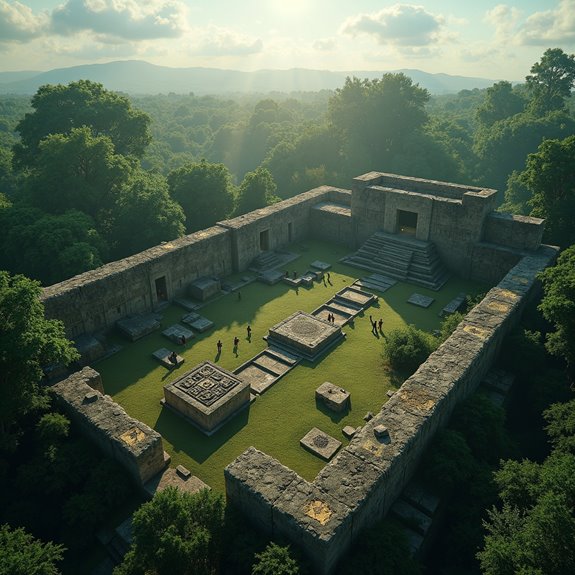Is There Proof of Ancient High Technology?
The debate over ancient high technology raises intriguing questions about humanity’s past. Evidence from remarkable structures and sophisticated artifacts suggests that ancient civilizations may have possessed advanced engineering capabilities. The precision of the Great Pyramids and the enigmatic stones at Baalbek challenge modern assumptions. As researchers continue to uncover more findings, the quest for understanding lost technologies becomes increasingly complex. What other secrets could lie hidden beneath layers of history?
Introduction

Throughout history, there have been tantalizing hints that ancient civilizations possessed technology far more advanced than what we typically associate with their time. Archaeological discoveries often reveal artifacts and structures that baffle modern experts, leading many to reconsider traditional narratives about human development. From the precision of stone-cutting techniques used in ancient pyramids to the intricate machinery found in historical ruins, evidence suggests a lost knowledge that surpasses what’s currently understood. These findings spark curiosity and challenge existing paradigms, prompting researchers to explore whether ancient cultures utilized tools and methods that are now lost to time. The implications of such discoveries could redefine our understanding of technological evolution and human ingenuity throughout history.
Ancient Advanced Engineering Techniques

While many assume ancient builders relied solely on primitive tools, evidence suggests they employed sophisticated engineering techniques that still astonish modern experts. Archaeologists have uncovered remarkable structures featuring precise stone cutting and alignment, far surpassing basic methods of the time. Techniques like levers, pulleys, and advanced measurement systems likely played a vital role in the construction of monumental sites. Furthermore, ancient cultures demonstrated an impressive understanding of materials, using basalt, limestone, and other stones for peak durability and aesthetics. They also incorporated knowledge of astronomy and geography, ensuring that their buildings aligned with celestial events and landscape features. This blend of innovation and practical skill highlights their unparalleled ability to tackle complex engineering challenges, ultimately reshaping perceptions of their capabilities.
Notable Cases or Sightings

Ancient civilizations left behind remarkable evidence of their high technology in various notable sites around the world. The Great Pyramids of Giza showcase incredible engineering precision, with stones weighing several tons perfectly aligned. In South America, the Machu Picchu ruins demonstrate sophisticated agricultural terraces and stone constructions that have withstood centuries of seismic activity. Similarly, the massive stones of Baalbek in Lebanon point to advanced transport and construction techniques, as some blocks weigh over a thousand tons. Mystery also surrounds the Nazca Lines in Peru, which some argue could only be appreciated from the skies, implying aerial observation capabilities. Finally, the intricate metalwork found in the ancient ruins of Baghdad hints at engineering skills beyond what’s typically attributed to their era.
Common Theories or Explanations
Many enthusiasts of ancient high technology propose a variety of theories to explain the incredible feats of these civilizations. One common theory suggests advanced civilizations had access to now-lost technologies, allowing them to construct monumental architecture with precision. Another theory posits that ancient peoples utilized a combination of natural phenomena and advanced mathematics, enabling them to harness energy sources long forgotten. Some advocate for the idea that extraterrestrial beings influenced these societies, sharing knowledge that propelled them beyond their time. Additionally, proponents argue that oral traditions and ancient texts contain hints of this lost wisdom. Each theory aims to illuminate how civilizations seemingly defied the limitations of their time, reflecting humanity’s enduring fascination with the past.
Frequently Asked Questions
What Ancient Artifacts Suggest High Technology Existed?
Ancient artifacts like the Antikythera mechanism, Baghdad Battery, and the Piri Reis map suggest advanced technology existed. These discoveries reveal complex engineering and astronomical knowledge, sparking curiosity about the capabilities of ancient civilizations.
Are There Ancient Texts Referencing Advanced Technologies?
Many ancient texts, like the Vedic scriptures and Greek writings, reference advanced technologies. They describe flying machines, incredible weaponry, and complex engineering, suggesting past civilizations possessed knowledge that seems surprisingly advanced for their time.
Did Ancient Civilizations Communicate Technology Knowledge Across Cultures?
Ancient civilizations likely communicated technological knowledge across cultures, as evidenced by similarities in architecture, metallurgy, and agricultural practices. Trade routes and cultural exchanges facilitated the sharing of ideas, enhancing their skills and innovations collectively.
How Do Scientists Investigate Claims of Ancient High Technology?
Scientists investigate claims of ancient high technology by analyzing artifacts, conducting archaeological studies, and utilizing advanced dating techniques. They compare findings across cultures to identify similarities and assess the plausibility of technological advancements in ancient civilizations.
What Are the Biggest Misconceptions About Ancient Technology?
Many believe ancient civilizations lacked sophistication, but they actually demonstrated remarkable skills. Misconceptions often include underestimating their engineering abilities and overemphasizing lost knowledge, leading to a distorted view of humanity’s technological evolution throughout history.


